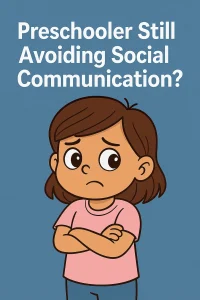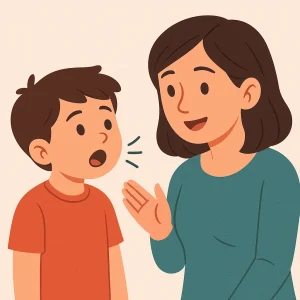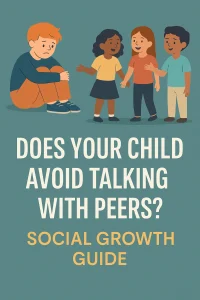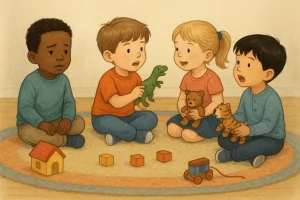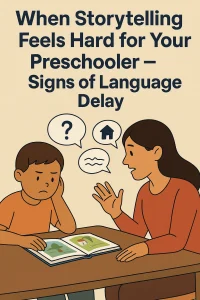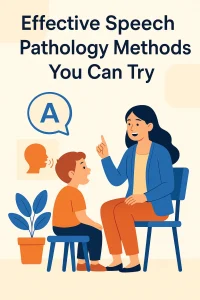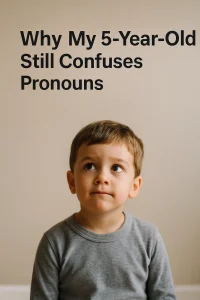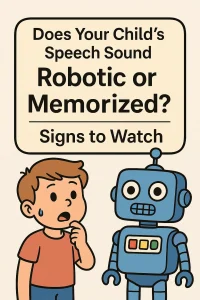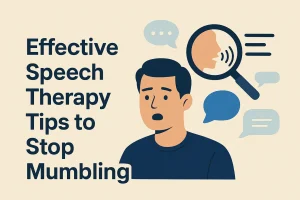Missing Sounds in Toddler Speech: What’s Normal and What’s Not
Last Updated: July 28, 2025
It’s common for toddlers to mispronounce words or drop sounds as they learn to talk — but how do you know what’s part of normal speech development and what could be a red flag? Missing sounds in toddler speech can leave many parents worried, especially when other kids the same age seem to speak more clearly. Understanding the difference between typical articulation delays and signs of a potential speech delay or even early signs of autism is key.
Free Speech Help for Kids
Concerned about speech delays? Book a free consultation with our expert speech therapist and get guidance tailored to your child’s needs.
Speech Development Milestones by Age
What Sounds Should My Toddler Be Saying — and When?
Every toddler develops at their own pace, but there are general speech development milestones by age that help us understand what’s typical. Knowing when your child should start saying certain sounds can ease anxiety — or help you take early action if something feels off.
Here’s a simple breakdown of what to expect from 12 months to 3 years:
Speech Milestones by Age
2 Months (1 Year Old)
- Expected Sounds:
- Babbling using b, m, and d sounds (e.g., “baba”, “mama”, “dada”)
- Starts saying a few simple words meaningfully (e.g., “hi”, “bye”, “uh-oh”)
- Responds to their name and simple instructions with gestures or vocal responses
18 Months
- Expected Sounds:
- Vocabulary of 10–20 words
- Begins combining gestures with words (e.g., pointing + saying “ball”)
- Tries to copy sounds more often
- Uses early consonants like p, b, m, d, n
- Speech Clarity: Most speech is still unclear to unfamiliar listeners, but speech milestones at 18 months include increasing word attempts.
- Note: If your toddler has fewer than 10 words or is not trying to imitate sounds, it’s a good idea to observe more closely or consult a professional.
24 Months (2 Years Old)
- Expected Sounds:
- Uses 50+ words
- Combines two words: “more milk,” “mama go,” “big car”
- Starts using new consonants: t, k, g, h
- Begins dropping ending sounds (e.g., “ca” for “cat”) — normal at this stage
36 Months (3 Years Old)
- Expected Sounds:
- Vocabulary of 200+ words
- Speaks in 3–4 word sentences: “I want juice,” “Daddy go work”
- Can be understood by most familiar adults ~75% of the time
- Mastery of more consonants: f, s, y
- Still developing harder sounds: r, l, th, and sh (these come later)
- Speech Milestones at 3: By now, toddlers should be actively using language to express needs, describe, and ask simple questions.
Why Milestones Matter
These age-wise milestones give us a helpful guide, but remember — children don’t hit them at exactly the same time. A few months of delay might still fall within the typical range. However, if your toddler isn’t making consistent progress, especially in combining sounds or being understood, early support can make a big difference.
Pro Tip: Use a Milestone Tracker
Keep a simple journal or download a printable speech development milestone chart to track your child’s speech growth. This makes it easier to notice if they’re skipping certain sounds or patterns over time.
What’s Normal: Common Sound Errors in Early Speech
As toddlers learn to speak, it’s perfectly normal for their words to sound a little “off.” They’re just beginning to coordinate their lips, tongue, and breath to form sounds—and it takes time and practice. That’s why things like dropping sounds, swapping letters, or saying funny versions of words are very common in early speech development.
So, before you worry, let’s take a closer look at normal toddler speech mistakes and the speech sounds toddlers commonly skip.
Common & Completely Normal Sound Errors in Toddlers
1. Dropping Final Sounds
You may hear your toddler say “ca” instead of “cat” or “do” instead of “dog.”
This is one of the most common normal toddler speech mistakes and usually resolves on its own by age 3½.
Example:
- “ba” for “ball”
- “cu” for “cup”
- “uh” for “up”
Why it happens: Toddlers tend to focus on the beginning of a word and haven’t yet mastered finishing sounds.
2. Swapping Difficult Sounds
Toddlers often replace harder sounds with easier ones. This is called phonological substitution.
Examples:
- “wabbit” instead of “rabbit”
- “fum” instead of “thumb”
- “tat” instead of “cat”
These types of substitutions are expected as part of learning. Over time, their brain and mouth learn to work together to say the correct sounds.
3. Skipping Multi-Syllable Words
Words with more than one syllable can be tricky! Toddlers may shorten them or leave out parts.
Examples:
- “nana” for “banana”
- “puter” for “computer”
- “getti” for “spaghetti”
This is totally normal in early speech development and usually improves as vocabulary and memory grow.
4. Struggling with “R”, “L”, “TH”, and “SH” Sounds
These sounds are typically learned later — sometimes as late as age 6 or 7. So if your 2- or 3-year-old can’t say them, don’t panic.
Examples:
- “yight” for “light”
- “wed” for “red”
- “sumb” for “thumb”
These are among the most skipped speech sounds in toddlers, and professionals only begin to look closely if these errors persist past age expectations.
Also read: Mastering the ‘SH’ Sound: Easy Techniques and Tips
When Is It Just a Phase?
If your child is:
- Making progress over time
- Trying to imitate sounds
- Combining words into phrases
- Understandable to you, even if not to strangers
…then these speech errors are likely just part of normal articulation development.
But if your toddler is dropping many sounds, using very few words, or becoming increasingly frustrated while speaking, it may be worth seeking guidance from a speech-language pathologist.
Quick Reminder
Every child is unique. Toddler dropping sounds isn’t always a red flag — but watching how their speech evolves month-to-month gives you the clearest picture. Keep note of new words, how they say them, and whether certain sounds are consistently left out.
When to Be Concerned: Signs of Speech Delay or Disorder
It’s completely natural to wonder if your toddler is just taking their time—or if their speech difficulties signal something more serious. While many kids go through phases of unclear speech or mispronunciations, there are some clear toddler speech delay signs that parents should watch for.
Let’s explore when speech struggles are a normal part of development… and when they might indicate a speech delay or speech disorder.
What’s the Difference Between a Speech Delay and a Speech Disorder?
Understanding the difference can help you take the right steps early on:
| Term | What It Means | Example |
|---|---|---|
| Speech Delay | Your child is following the typical pattern of development but is slower than expected. | A 2-year-old uses only a few words when peers are using short phrases. |
| Articulation Delay | Difficulty producing certain sounds clearly. Often a mechanical or motor issue. | Saying “wed” for “red” or “tup” for “cup” well past age 3. |
| Phonological Disorder | A pattern of sound errors that make speech hard to understand, often involving rules the brain applies to language. | Replacing all “k” sounds with “t” (“tat” for “cat”) or dropping final consonants frequently. |
So while articulation delay is about difficulty with specific sounds, phonological disorder is about broader patterns that affect overall speech clarity in toddlers.
Toddler Speech Delay Signs to Watch For
If your child shows any of the following signs, it may be time to consult a speech-language pathologist:
12–15 Months:
- Shows little to no babbling
- May not say basic sounds like “mama” or “dada”
- Fails to respond to their name consistently
18 Months:
- Has a vocabulary of fewer than 10 words
- Rarely points or uses gestures to communicate
- Makes little effort to imitate sounds or words
24 Months:
- Uses fewer than 50 words
- Struggles to combine two words, such as “want juice” or “go car”
- Remains hard to understand even for close family members
At 36 Months:
- Understandable only to parents; unfamiliar listeners have difficulty
- Frequently drops beginning or ending sounds in words
- Shows low interest in speaking or trying new words
These speech delay signs in toddlers may go beyond normal variation. The earlier you notice and act, the better the chance for your child to receive the support they need during this critical window of development.
Could It Be Autism?
Many parents ask about the connection between speech delay vs autism. It’s important to remember:
- Speech delay alone does not mean autism.
- Children with autism may also have speech delays, but they typically show other signs too—like avoiding eye contact, not responding to their name, or not using gestures to communicate.
If your child is not just struggling with words but also shows differences in social interaction, repetitive behaviors, or limited interest in people, you may want to speak with both a speech therapist and a developmental pediatrician.
What to Do If You’re Concerned
If you’ve noticed any of these signs, trust your instincts. You don’t need to wait. Pediatricians often recommend a “wait and see” approach, but early support is always better than late support.
You can:
- Schedule a speech-language evaluation
- Use a speech therapy app to try guided home-based activities
- Track progress weekly with a printable speech chart
- Talk to your child’s doctor or preschool teacher for insight
The Bottom Line
Not every unclear word is a reason to worry. But when speech clarity in toddlers consistently lags behind expectations—or when your child struggles to express themselves—it’s okay to ask questions and seek help.
Early intervention can not only improve speech—it can boost confidence, reduce frustration, and support overall communication and learning.
Could It Be Autism? Understanding the Overlap
It’s one of the biggest worries on a parent’s mind: Is my child’s speech delay just a phase—or could it be something more, like autism?
If your toddler is missing sounds, speaking unclearly, or has stopped saying words they used to know, it’s normal to feel concerned. While not every speech delay points to autism, understanding the difference between a simple speech delay and the early signs of autism in toddlers can help you make informed decisions.
Is Missing Sounds a Sign of Autism?
Let’s start with this: missing sounds alone does not automatically mean your child is autistic. Many toddlers go through phases where they:
- Drop sounds at the end of words
- Substitute easier sounds for harder ones
- Speak in single words or short phrases
These are often part of typical speech development, or sometimes a speech delay or phonological delay.
However, when unclear speech is accompanied by other developmental red flags, it may point to something broader—like autism.
Speech Delay vs Autism: What’s the Difference?
Here’s a quick side-by-side to help clarify:
| Feature | Speech Delay | Autism Spectrum Disorder (ASD) |
|---|---|---|
| Responds to Name | Yes | Often No |
| Uses Gestures (pointing, waving) | Yes | Rarely or Inconsistently |
| Tries to Imitate Sounds/Words | Yes | May not try to imitate |
| Makes Eye Contact | Yes | Limited or avoids it |
| Interest in People | Shows interest | May prefer objects or repetitive actions |
| Repeats Phrases or Lines | Rare | Common (echolalia) |
| Regression in Skills | Rare | More common (especially between 15–30 months) |
So, if your child is only having trouble with speech sounds but interacts socially, responds to their name, and tries to communicate — it’s more likely to be a speech delay rather than autism.
But if unclear speech is paired with limited social interaction, lack of gestures, or loss of previously used words — these could be early signs of autism in toddlers.
What Is Toddler Speech Regression?
Speech regression refers to a child losing words or skills they previously had. For example:
- A toddler who used to say “mama” and “bye” suddenly stops speaking those words.
- A child who once pointed at things no longer gestures at all.
This kind of regression, especially when paired with changes in behavior or reduced social interaction, is a potential red flag and should be evaluated quickly.
Toddler speech regression and autism can be linked, but regression may also occur in children without autism due to other developmental concerns, hearing issues, or emotional stressors.
What Should You Do If You’re Unsure?
If you’re worried your child’s missing sounds or unclear speech might be tied to autism:
- Schedule a developmental screening with your pediatrician
- Consult a speech-language pathologist (SLP) for a speech evaluation
- Use screening tools or autism detection apps designed for toddlers
- Track your child’s progress and social behaviors week-to-week
The Bottom Line
Speech delays are common. Autism is not defined by speech struggles alone. But when language challenges are paired with social communication differences, it’s worth exploring further.
Early signs of autism in toddlers can be subtle, but early support changes everything. Whether your child needs speech therapy, developmental play, or a formal diagnosis, the goal is the same: to help them connect, communicate, and thrive.
How to Help at Home: Encouraging Clearer Speech
If you’re concerned about your toddler’s speech clarity, the good news is — there’s a lot you can do right at home. Many parents don’t realize that small, everyday activities can have a big impact on how well their child learns to talk.
While professional speech therapy is helpful (and sometimes necessary), home-based speech activities can lay a strong foundation and speed up your child’s progress — all while strengthening your bond.
Simple Home Activities to Boost Speech Clarity
Here are some fun, low-pressure ways to help your toddler speak more clearly:
1. Talk All Day
Use every opportunity to talk to your toddler — while dressing, cooking, or walking. Use simple, clear language and repeat words often.
Example:
“Let’s put on your blue socks. Blue socks go on your feet!”
Why it works: Repetition helps toddlers recognize and practice sounds in context.
2. Read Together (Every Day!)
Choose books with rhyme, rhythm, and repetition. Point to pictures and name them clearly. Pause and encourage your child to try saying the words.
Try books like:
- Brown Bear, Brown Bear
- Goodnight Moon
- First 100 Words
This helps with speech clarity in toddlers by exposing them to proper sound patterns.
3. Use Mirror Play
Sit in front of a mirror with your child and make silly sounds or faces. Encourage them to copy your lips and tongue movements.
Example:
- Say “ba, ba, ba” and watch each other’s lips.
- Try blowing raspberries or puffing cheeks.
These exercises build oral motor strength and control — key for forming clear speech.
4. Name What You See
During playtime, name the toys, colors, and actions. Pause and wait to see if your child tries to copy you.
Example:
- “Car! The car is going fast! Vroom!”
Repeating and emphasizing key words encourages sound imitation and vocabulary growth.
5. Try Speech Games
Turn learning into a game:
- Sound Sorting – Group toys by starting sounds (e.g., “B” for ball, book, bear)
- Sing-Along Time – Songs like “Old MacDonald” and “Wheels on the Bus” encourage verbal participation
- Yes/No Game – Ask questions they can answer with a nod or word
These activities boost speech clarity by making practice fun and natural.
Use Technology to Support You
There are many apps to help toddlers talk that are backed by speech therapy experts. These can reinforce the skills your child is learning and provide structure to your home routine.
Top Features to Look For:
- Simple word repetition
- Clear visuals and sounds
- Imitation games and rewards
- Progress tracking
If you’re using an Speech and Autism therapy app – BASICS, you can follow daily activities, get professional guidance, and monitor your child’s improvement over time — all from your phone.
Tips from Speech Therapists
Speech therapists recommend the “3 Ps” for home-based speech support:
- Patience – Give your child time to respond. Avoid correcting too quickly.
- Praise – Celebrate attempts, not perfection.
- Practice – Short, daily sessions work better than occasional long ones.
Even 10 minutes of focused speech play each day can make a big difference!
When and How to Seek Professional Help
Sometimes, even with your best efforts at home, you might still feel unsure. Is my toddler just taking their time? Or is something more going on?
If you’ve noticed consistent issues like unclear speech, limited vocabulary, or frustration during communication, it may be time to consider a professional opinion. Knowing when to seek a speech-language evaluation can make a huge difference — because early action leads to better outcomes.
Signs That It’s Time to Seek Help
If your toddler:
- Isn’t saying at least 10 words by 18 months
- Struggles to combine two words by age 2
- Is hard to understand, even to close family
- Seems frustrated when trying to speak
- Has stopped using words they used to know
- Doesn’t imitate sounds or respond to their name
…these may be signs that your child needs more support than home activities alone can offer.
These are also key speech delay warning signs that parents should not ignore. A speech-language pathologist (SLP) can assess how your child is communicating, understand any underlying issues, and guide you through next steps.
Why Early Intervention Matters
The earlier you act, the better the outcomes. Children’s brains are most adaptable in the first 3–5 years of life. Early support can help your child:
- Catch up with peers
- Avoid future learning difficulties
- Build confidence in social situations
- Improve overall communication and emotional expression
Delaying help often leads to more frustration — both for your child and you. Instead of “wait and see,” think “watch and act.”
What Happens in a Speech Evaluation?
A typical evaluation involves:
- Observing how your child plays, listens, and responds
- Checking how many words they use and how clearly they speak
- Understanding how they use gestures or eye contact
- Identifying any speech sound errors or patterns
It’s play-based, parent-friendly, and can often be done online or in-person. There’s no pressure — just a helpful way to better understand your child’s needs.
Speech Therapy Support Made Simple
You don’t always have to go to a clinic. Today, many parents are turning to online speech therapy apps and virtual consultations that offer personalized plans and activities.
With platforms like Tele-BASICS, you can:
- Access certified speech-language therapists
- Follow daily practice sessions at home
- Track your child’s speech goals and progress
- Get expert feedback — all from your phone or tablet
The Role of Technology: Best Speech Therapy Apps for Toddlers
Technology is transforming the way we support children’s development — and speech therapy is no exception. Whether you’re on the go, in a remote area, or just looking for extra practice between sessions, the right speech therapy app for toddlers can be a powerful tool in your parenting toolkit.
Apps are no longer just games — many are designed by speech-language pathologists and early childhood experts to help children build vocabulary, improve sound clarity, and even support kids with autism in learning how to communicate.
Why Use a Speech Therapy App?
If you’re wondering whether an app can really make a difference, the answer is yes — when used with purpose and consistency. Here’s how the best speech therapy apps support your child’s growth:
1. Daily Practice, Anywhere
Apps allow toddlers to practice speech exercises anytime — during quiet time, on a car ride, or right before bed. This consistency reinforces what they’re learning through play.
2. Visual and Auditory Cues
Interactive visuals and clear voice prompts help toddlers understand and imitate sounds better. These features are especially helpful for children with autism speech challenges, who may need extra visual support.
3. Personalized Learning
Some apps offer progress tracking and adaptive levels. As your child masters a sound or word, the activities become more challenging — just like a real therapy plan.
4. Parental Involvement
Apps often include guided activities and tips for parents, so you’re not left guessing what to do. You become an active part of the therapy process.
Featured App: BASICS
One standout option is BASICS, a holistic app created by certified therapists to support speech, social, and learning development — especially in young children with speech delay, autism, or developmental differences.
BASICS offers:
- Story-based therapy activities that engage toddlers
- Step-by-step programs for speech sounds, first words, and more
- Printable resources and real-time feedback from therapists
- Guided support for parents and caregivers at home
Whether your child is just starting to talk or needs targeted help with articulation, Tele-BASICS makes therapy feel like play.
Who Can Benefit from BASICS – Speech Therapy App?
- Late talkers who need extra support at home
- Children with mild to moderate speech clarity issues
- Toddlers with autism who need structured, visual communication tools
- Parents looking for affordable, accessible speech practice outside of formal sessions
If you’re looking for the best speech therapy app for your toddler, consider what your child enjoys — games, stories, music — and choose an app that fits their learning style.
Final Tip
Apps aren’t meant to replace a licensed therapist when professional intervention is needed. But they complement therapy, reinforce daily practice, and make speech learning more engaging — right in your living room.
Printable Resources and Support Tools
Sometimes, having the right tools at your fingertips can make all the difference. Whether you’re just starting to monitor your child’s speech or looking for ways to stay consistent with home practice, printable speech tools can be a big help — especially for busy parents.
These resources are designed by speech-language experts to support your child’s growth in a simple, visual, and trackable way. You don’t need to be a therapist to use them — just a parent who wants to help.
What Can You Print and Use Today?
Here are some of the most helpful printable speech therapy resources you can use at home:
1. Speech Sound Development Chart
- Shows which consonants and sounds are typically mastered by age
- Helps you spot whether your child is on track or missing key sounds
- Great reference for understanding when to expect certain sounds like “r,” “sh,” or “th”
2. Toddler Speech Milestone Checklist
- Age-specific speech expectations from 12 months to 3 years
- Simple yes/no format to monitor what your toddler can do now
- Encourages regular check-ins so you can notice improvements — or plateaus
Take the free speech and communication test for ages 1–7 and get expert guidance on your child’s development today.
3. Daily Speech Activity Tracker
- A weekly sheet where you log what activities you did
- Helps you stay consistent with home-based speech activities
- Can be shared with a speech therapist to track progress or adjust goals
Why Use Printables?
- Visual Clarity: Easier to reference than digital screens
- Consistency: Encourages routine practice
- Empowerment: Helps you feel more confident supporting your toddler’s speech at home
These printable tools are especially helpful for parents who feel unsure about what’s normal — or who just want to take an active role in speech support.
Conclusion
As a parent, you know your child best. If you feel something is off with their speech — like unclear words, missing sounds, or slow talking — trust your gut. Many toddlers need a little extra support, and that’s okay. Early action can make a big difference in how your child learns to speak and connect. Use simple tools like our speech therapy app for toddlers or easy home activities to help them grow. You’re not alone in this journey.
Frequently Asked Questions:
1. Why is my toddler not talking clearly?
Some toddlers take longer to learn how to say sounds clearly. This may be normal, but unclear speech after age 2 could mean a speech delay or articulation problem. It’s best to track their progress and talk to a speech therapist if you’re unsure.
2. Is it normal for my toddler to miss sounds when talking?
Yes, many toddlers drop sounds at the beginning or end of words. This is common in early speech development. But if your child still drops many sounds after age 3, it may need professional support.
3. What age should toddlers start using clear words?
By age 2, toddlers should be using at least 50 words and combining two words. Most kids are about 50–75% understandable to familiar adults. If your child’s speech is hard to understand, it’s worth checking in with a speech expert.
4. When should I worry about my toddler’s speech?
If your toddler isn’t saying 10 words by 18 months or 50 words by age 2, or if speech isn’t improving over time, it could be a speech delay. Trust your instincts and get a screening if you’re worried.
5. Is unclear speech a sign of autism in toddlers?
Unclear speech alone is not enough to diagnose autism. But if it’s combined with poor eye contact, not responding to their name, or not using gestures, it could be an early sign of autism. A specialist can help you understand the difference.
6. What are the best speech therapy apps for toddlers?
Apps like Tele-BASICS are designed by experts to support speech, especially for kids with speech delay or autism. The best speech therapy app should include guided activities, clear visuals, and tools for parents.
7. Can I help my toddler talk better at home?
Yes! Simple things like talking to your child often, reading books together, playing word games, and using a speech app can improve speech clarity. Daily practice, even for 10 minutes, can make a big difference.
8. What are normal speech milestones for toddlers?
- 12 months: babble and say “mama” or “dada.”
- 18 months: say at least 10 words.
- 24 months: use 2-word phrases and over 50 words.
- 36 months: speak in sentences and be mostly understood by others.
9. What is speech regression in toddlers?
Speech regression means a toddler suddenly stops using words they used to say. This could be a sign of stress, hearing issues, or autism. It’s important to get help quickly if you notice this change.
10. How can I track my toddler’s speech progress?
You can use a toddler speech sound tracker or milestone checklist to see which sounds your child is saying and if they’re on track. Download our free printable chart to start tracking today.
About the Author:
Anuradha Karanam
Speech-language pathologist (7+ years of experience)
Anuradha Karanam is a skilled speech-language pathologist with over 6 years of experience. Fluent in Tamil, Telugu, Hindi, and English, she specializes in parent counseling, speech sound disorders, fluency assessment, and speech-language evaluations. Anuradha excels at working with children with developmental disorders, offering creative and effective therapy programs. Currently, at Wellness Hub, she holds a BASLP degree and is registered with the RCI (CRR No A85500). Her patience, ambition, and dedication make her a trusted expert in her field.
Book your Free Consultation Today
Parent/Caregiver Info:
Client’s Details:
* Error Message
